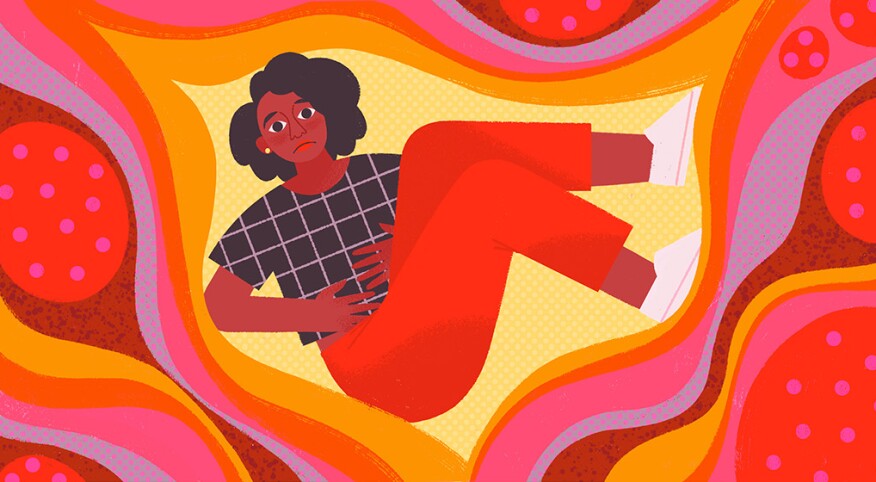My symptoms were bladder pain, severe fatigue, mood swings and rapid weight gain. At times I went months without a period, but when “Aunt Flo“ did decide to make her monthly debut, she came with a vengeance: heavy blood flow, lots of blood clots, extreme cramps and lower back pain. And my stomach protruded as if I were four months pregnant for at least two years.
The signs of an issue were there, but it wasn’t until I fainted on a flight in November 2017 that I fully realized the severity of what was happening with my body. And I learned my body was in big trouble.
While on the three-hour flight, I suddenly experienced pelvic and abdominal pain and massive bleeding. I also became cold, clammy and hot at the same time! I was weak and could no longer fight the excruciating pain or the light-headedness. My heart seemed to be beating out of my chest, forcing me to become short of breath.
Before I knew it, I was curled up in a fetal position on top of the flight attendant’s lap, preparing for an emergency landing due to my “unknown” illness. Initially, a regular pelvic exam didn’t detect the abnormalities taking shape within my reproductive tract, but quite honestly, I hadn’t been visiting the OB-GYN for my annual appointments. For the most part, I was healthy, but in my naive state of mind, I figured the signs and symptoms I was experiencing were part of the natural aging process and not tied to a larger health issue.
I soon realized not visiting the OB-GYN was a huge mistake. After scheduling an emergency appointment for an ultrasound, the results confirmed what my doctor suspected. Fibroids were the culprit of what had been affecting my physical, emotional and reproductive health. Six, to be exact.
Uterine fibroids, also called just “fibroids,” are tumors made of smooth muscle cells and fibrous connective tissue that develop in the uterus, according to UCLA Health. The “most important characteristic of fibroids is that they’re almost always benign, or noncancerous,” UCLA reports, noting that studies show fibroids grow at different rates and that “they can range from the size of a pea to (occasionally) the size of a watermelon.”
This summer I finally underwent surgery to hopefully bring an end to the debilitating symptoms I’d been suffering through for years. As my fibroids grew larger, over time my uterus became deformed and the growth blocked the opening of my cervix. Because of this, a scheduled 2 1/2-hour surgical procedure lasted almost five hours. The doctor made an incision about 3 to 4 inches along my bikini line to remove the six fibroids during my abdominal myomectomy. A small telescope (hysteroscope) was also inserted through my vagina and cervix and into my uterus so the doctor could see inside my uterus and take out a cervical polyp.
During my recovery period, I found comfort in knowing that I wasn’t alone. However, my support system of Black women who experienced the same symptoms was an all too familiar tune. Many women I spoke to admitted that they had no symptoms, suffered from severe symptoms or did not recognize the signs, which created a blurred line between normal and abnormal, resulting in a delay on their end in seeking treatment. But how did we all get to this point?
Some reasons for these issues are unknown. But we do know Black women tend to be younger when they get fibroids and have larger and more numerous tumors, according to Management of Uterine Fibroids from the Agency for Healthcare Research and Quality. And “by age 49, more than 70 percent of white women and 84 percent of African American women have fibroids documented by imaging or surgical records,” the agency confirms.
This entire ordeal took a heavy toll on my self-esteem and well-being and created a great deal of emotional distress. But post-surgery, I can honestly say my mind is at ease, my body is continually healing and I feel a sense of relief. I’m no longer emotionally exhausted due to the lingering uncertainty.
Looking back, here’s what I wish I knew.
When the body speaks, listen. I think being aware of the body-mind connection is essential to your overall health. I’ve learned negative energy, stress and trauma can show up in our bodies in various forms and trigger health effects. In finding balance, I’ve been intentional in equally nourishing my mind, body and spirit. It has helped me during my healing journey and played a tremendous role in strengthening my mental and physical interconnectedness.
Seek answers. The key to good communication and building a genuine relationship with your health care provider is to ask questions. Building trust with your provider can lead to quality health care results. Be proactive in your pursuit to learn about the ever changing dynamics of your body. Your health is wealth, and both you and your provider play an important role.
Don’t skip recommended exams. Even if you’re seemingly in tip-top shape, staying up to date with recommended screenings can be beneficial for your long-term health. Early intervention and preventative care can help spot irregularities and prevent health issues in the future. So, talk to your provider about which health screenings she recommends, even after perimenopause or menopause.
There is a need for greater awareness about fibroids, and it is my hope that in sharing my journey, more women will realize they do not have to fight this battle against fibroids alone or endure agonizing pain in silence. But what’s most important is that they’ll feel empowered to ask questions and speak openly about the effects of this condition.

Loris Lora










